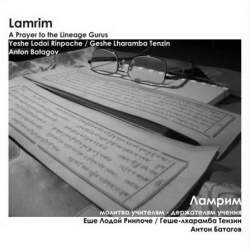Lamrim
Click here to see other articles relating to word Lamrim
lam-rim: A system of teaching Buddhism in Tibet that was started by Atisha.
See; Tsongkhapa's Lam-rim chenmo as an example. Lamrim (Tibetan: "stages of the path") is a Tibetan Buddhist textual form for presenting the stages in the complete path to enlightenment as taught by Buddha.
In Tibetan Buddhist history there have been many different versions of lamrim, presented by different teachers of the Nyingma, Kagyu and Gelug schools.
However, all versions of the lamrim are elaborations of Atiśa's 11th Century root text A Lamp for the Path to Enlightenment (Bodhipathapradīpa)
When Atiśa, the originator of the lamrim came from India to Tibet, he was asked by king Jang Chub Ö to give a complete and easily accessible summary of the doctrine in order to clarify wrong views, especially those resulting from apparent contradictions across the sutras and their commentaries.
Based upon this request he taught what came to be known as the lamrim for the Tibetans.
He was subsequently honored for this by the pandits of his alma mater in India, the monastic university of Vikramaśīla. Atiśa's presentation of the doctrine later became known as the Kadampa tradition in Tibet.
Gampopa, a Kadampa monk and student of the famed yogi Milarepa, introduced the lamrim to his disciples as a way of developing the mind gradually.
His exposition of lamrim is known in English translation as "The Jewel Ornament of Liberation" and is studied to this day in the various Kagyu schools of Tibetan Buddhism.
Tsongkhapa, founder of the Gelug school which is primarily based on Atiśa's Kadampa school, wrote one of his masterpieces on lamrim:
The Great Treatise on the Stages of the Path of Enlightenment (Tib. Lam-rim Chen-mo) which has about 1000 pages, and is primarily based on literary sources.
There is also a medium-length lamrim text by Tsongkhapa (200 pages) and a short one, called Lam-rim Dü-dön (Tib.), which is recited daily by many Gelugpas and is about 10 pages long.
Authenticity of the lamrim teachings
Tibetan Buddhists believe that the teachings of the lamrim are based on the sutras that the Buddha taught and that the Buddha taught the short, middling and extensive wisdom sutra simultaneously.
These wisdom sutras were taken by Maitreya and Asaṅga as the starting point for their encyclopaedic work, the Ornament of clear realizations (Abhisamayālaṃkāra) in which they emphasised the hidden meanings of the sutras.
The hidden meanings are believed to be contained in the number and order of the subjects.
The number and order of the subjects are vital if someone wants to put the philosophy into practice.
According to Lord Tsong Khapa in his Lam Rim Chen Mo, Atiśa took the number and order of the subjects in the Ornament of clear realizations (Abhisamayālaṃkāra) as the basis to write the first lamrim text: the Lamp of the Path that therefore contains the essential points of all sutra teachings in their logical order for practice.
Three kinds of motivation
The starting point of the lamrim is a division of Buddhist practitioners into beings of three scopes, based upon the motivation of their religious activity.
Disregarded in this division are individuals whose motives revolve around benefits in their current life. Striving for a favorable rebirth is implicitly the minimum requirement for an activity or practice to be classified as spiritual.
Atiśa wrote in "Lamp of the Path" (verse 2) that one should understand that there are three kind of persons:
Persons of modest motive search for happiness within samsara; their motive is to achieve high rebirth. Buddhists traditionally consider that this domain includes followers of most non-Buddhist religions who strive for a rebirth in a heaven.
Persons of medium motive are searching for their own ultimate peace and abandon worldly pleasure. This includes the paths of pratyekabuddhas and śravakabuddhas, which seek personal liberation alone, the traditional goal of Hīnayāna practice.
Based on their insight of their own suffering, persons of high motive seek by all means to stop the suffering of all beings. This is the Mahāyāna path of the samyaksaṃbuddhas.
Although lamrim texts cover much the same subject areas, subjects within them may be arranged in different ways.
The lamrim of Atiśa starts with bodhicitta, the altruistic mind of enlightenment, followed by taking the bodhisattva vows.
Gampopa's lamrim, however, starts with the Buddha nature, followed by the preciousness of human rebirth. Tsongkhapa's texts start with reliance on a guru (Tib.: lama), followed by the preciousness of human rebirth, and continue with the paths of the modest, medium and high scopes.
Gampopa and Tsongkhapa expanded the short root-text of Atiśa into an extensive system to understand the entire Buddhist philosophy. In this way, subjects like karma, rebirth, Buddhist cosmology and the practice of meditation are gradually explained in logical order.
A commonly used outline for lamrim teachings today in English translation from Tibetan is that of Liberation in the Palm of your Hand by Pabongka Rinpoche. An abbreviated and annotated outline follows to show the structure of this lamrim.
the greatness of the author of the lamrim, to establish the authenticity of the teaching
the greatness of the lamrim itself, to gain respect for it
the way the instructions are to be received and given
the way the students are to be guided through the subjects
this fourth subject has two divisions:
the way to rely on a spiritual guide
the way to train your mind on the basis of the correct way to rely on the spiritual guide
This last heading contains the rest of the instructions under the headings:
the way to encourage yourself to take the essence of this precious human rebirth
the way to take the essence of this precious human rebirth (that is: training your mind in the paths of the three scopes included within the lamrim)
The path shared with persons who have the modest scope motivation (striving for a rebirth in the upper realms)
the reality that this life will end and that you will die
the suffering in a rebirth in the lower realms (a rebirth as hell being, hungry ghost or animal, which you want to avoid)
(so you) take refuge in the three Jewels: Buddha, Dharma and Sangha
(and adjust your behavior of body, speech and mind according to the) law of cause and effect/ karma
which will lead you to a favorable rebirth within cyclic existence in the human-, demigod-, or god realm.
The path shared with persons who have the medium scope motivation (striving for liberation of cyclic existence)
The truth of suffering (in cyclic existence in general, including the favorable rebirths)
The truth of the causes of suffering (the afflictive emotions, especially ignorance)
The truth of cessation (there is a state that is free of suffering and its origins)
The truth of paths (the way to attain this state free of suffering and its causes by practicing ethics, concentration and wisdom)
Another presentation of the middle scope subjects is the presentation of the 12 links of dependent arising
The training in the medium scope path will lead to the development of the wish to be liberated from all un-free rebirths in cyclic existence through the power of afflictive emotions and karma
The path for persons who have the high scope motivation (striving for complete buddhahood)
the advantages of the mind of enlightenment (the wish to become a buddha for the welfare of all sentient beings)
the way to develop the mind of enlightenment
the 7-point instruction in seeing all sentient beings as your mothers (from previous lives and contemplating their kindness towards you)
the instruction on how to exchange your self-interest for others' interest (by looking at the drawbacks of self-cherishing and the advantages of cherishing others)
the way to train your mind after developing the mind of enlightenment
training in the perfection of generosity
training in the perfection of ethics
training in the perfection of patience
training in the perfection of joyful effort
training in the perfection of concentration
training in the perfection of wisdom
for a more detailed outline, see the external link "Lam Rim: The gradual Path to Enlightenment, Thubten Chodron's online Lamrim Outline"



